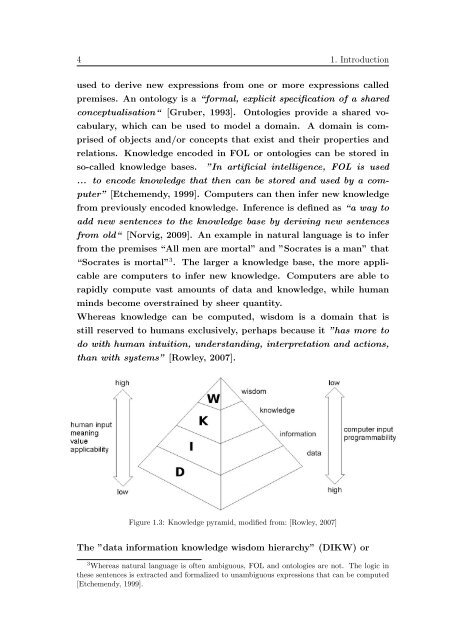Data integration in microbial genomics ... - Jacobs University
Data integration in microbial genomics ... - Jacobs University
Data integration in microbial genomics ... - Jacobs University
You also want an ePaper? Increase the reach of your titles
YUMPU automatically turns print PDFs into web optimized ePapers that Google loves.
4 1. Introduction<br />
used to derive new expressions from one or more expressions called<br />
premises. An ontology is a “formal, explicit specification of a shared<br />
conceptualisation“ [Gruber, 1993]. Ontologies provide a shared vocabulary,<br />
which can be used to model a doma<strong>in</strong>. A doma<strong>in</strong> is comprised<br />
of objects and/or concepts that exist and their properties and<br />
relations. Knowledge encoded <strong>in</strong> FOL or ontologies can be stored <strong>in</strong><br />
so-called knowledge bases. ”In artificial <strong>in</strong>telligence, FOL is used<br />
... to encode knowledge that then can be stored and used by a computer”<br />
[Etchemendy, 1999]. Computers can then <strong>in</strong>fer new knowledge<br />
from previously encoded knowledge. Inference is def<strong>in</strong>ed as “a way to<br />
add new sentences to the knowledge base by deriv<strong>in</strong>g new sentences<br />
from old“ [Norvig, 2009]. An example <strong>in</strong> natural language is to <strong>in</strong>fer<br />
from the premises “All men are mortal” and ”Socrates is a man” that<br />
“Socrates is mortal” 3 . The larger a knowledge base, the more applicable<br />
are computers to <strong>in</strong>fer new knowledge. Computers are able to<br />
rapidly compute vast amounts of data and knowledge, while human<br />
m<strong>in</strong>ds become overstra<strong>in</strong>ed by sheer quantity.<br />
Whereas knowledge can be computed, wisdom is a doma<strong>in</strong> that is<br />
still reserved to humans exclusively, perhaps because it ”has more to<br />
do with human <strong>in</strong>tuition, understand<strong>in</strong>g, <strong>in</strong>terpretation and actions,<br />
than with systems” [Rowley, 2007].<br />
Figure 1.3: Knowledge pyramid, modified from: [Rowley, 2007]<br />
The ”data <strong>in</strong>formation knowledge wisdom hierarchy” (DIKW) or<br />
3 Whereas natural language is often ambiguous, FOL and ontologies are not. The logic <strong>in</strong><br />
these sentences is extracted and formalized to unambiguous expressions that can be computed<br />
[Etchemendy, 1999].

















